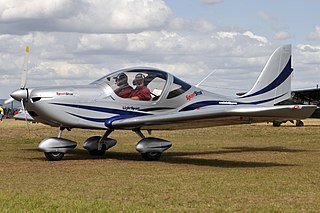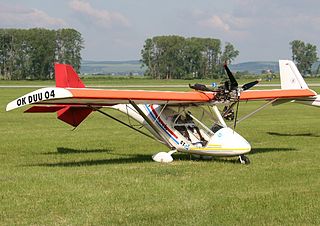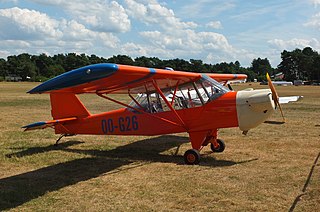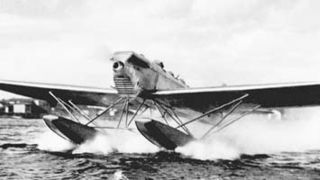
The Aero A.14 was a Czechoslovakian biplane military reconnaissance aircraft built in the 1920s. It was essentially a slightly modified version of the Hansa-Brandenburg B.I aircraft that Aero had built during World War I as the Ae.10, and for this reason, the aircraft is sometimes referred to as the A.14 Brandenburg. When equipped with a slightly different engine, the aircraft was designated A.15 instead. The two versions were otherwise almost identical.
The Auster Avis was a four-seat light aircraft developed from the Auster Autocrat. It featured a redesigned fuselage incorporating four doors and a circular cross-section towards the tail, new undercarriage, and new wing flaps. It was planned in two versions, the Mk 1 for civil use, and the Mk 2 for military and air ambulance duties. However, only two prototypes were built, and Auster abandoned the project in favour of the Auster J-5 Autocar.

The Breda A.4 was a biplane trainer produced in Italy in the mid-1920s. It was of conventional configuration with a two-bay unstaggered wing cellule and seating for the pilot and instructor in tandem open cockpits. Apart from civil use, the A.4 was also adopted by the Regia Aeronautica as a trainer. At least some examples were produced in floatplane configuration as the A.4idro.

The SportStar and EuroStar are a family of a two-seat, light sport aircraft (LSA), manufactured by Evektor-Aerotechnik of the Czech Republic and powered by a Rotax 912ULS, 100 horsepower (75 kW) engine.

The Focke-Wulf A 20 Habicht was an airliner developed in Germany in the late 1920s. It was a high-wing cantilever monoplane with fixed tailskid undercarriage. The fuselage was deep and seated four passengers in a fully enclosed cabin. The type was not bought by the airlines and only a few examples were built.

The PWS-50,(PWS - Podlaska Wytwórnia Samolotów - Podlasie Aircraft Factory), was a prototype Polish single-engine mid-wing monoplane sports aircraft of 1930, constructed by Podlaska Wytwórnia Samolotów.

The IMAM Ro.5 was a sport aircraft produced in Italy in the late 1920s. It was a conventional, parasol wing monoplane with fixed tailskid undercarriage and two open cockpits in tandem. It proved popular with private owners and flying clubs, and was built in large numbers. Some Ro.5s were purchased by the Regia Aeronautica for use as trainers and liaison aircraft. A later version, the Ro.5bis, enclosed the cockpits under a long canopy.
The Avid Champion is an American single-seat, high-wing ultralight aircraft that was produced starting in 1998 as a kit by Avid Aircraft of Caldwell, Idaho, later Ennis, Montana.
The EADS PZL PZL-112 Junior is a Polish single engine, two-seat trainer built by PZL Warszawa-Okecie.

The Falconar Minihawk is a Canadian amateur-built aircraft, produced by Falconar Avia. The aircraft is supplied as a kit or plans for amateur construction.

The Alisport Silent 2 Electro is an Italian mid-wing, single-seat motor glider, designed and produced by Alisport of Cremella and provided as a complete ready-to-fly aircraft. The aircraft was introduced at the Aero show held in Friedrichshafen in 2011.

The Yuneec EViva is a Chinese low-wing, two-seat motor glider that was designed by Martin Wezel is now under development by Yuneec International of Kunshan, Jiangsu.
The Fly-Fan Shark is a Slovak light aircraft designed by Frantisek Sustek and under development by Fly-Fan of Trenčín. The design was introduced at the AERO Friedrichshafen show in 2007 as a mock up and in 2011 as a flying aircraft. The aircraft first flew on 29 June 2011 and is intended to be supplied as a complete ready-to-fly-aircraft.
The Air Creation Twin is a French ultralight trike that was designed and produced by Air Creation of Aubenas. Production has been completed, but while the aircraft was available it was supplied as an assembly kit for amateur construction or as a complete ready-to-fly-aircraft.

The Letov ST-4 Aztek is a Czech microlight aircraft that was designed and produced by Letov Kbely of Prague - Letňany, in the 1990s. When it was available, the aircraft was supplied as a complete ready-to-fly aircraft, or as a kit for amateur construction.

The Ultracraft Calypso is a family of Belgian homebuilt aircraft designed and produced by Ultracraft of Heusden-Zolder, introduced in the 1990s. The aircraft is supplied as a complete ready-to-fly aircraft or as a kit for amateur construction.
The GS-600 Arrow is a Colombian homebuilt aircraft that was designed and produced by Ibis Aircraft of Cali, introduced in 2000. When the aircraft was available it was supplied as a complete ready-to-fly-aircraft or as a kit for amateur construction.
The Adventure Wheely II is a French powered parachute that was designed and produced by Adventure SA of Paris. Now out of production, when it was available the aircraft was supplied as a complete ready-to-fly-aircraft.

The Heinkel HE 9 was a reconnaissance seaplane developed by the German aviation company Ernst Heinkel Flugzeugwerke AG in the late 1920s.













